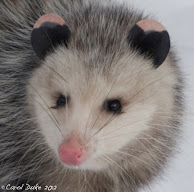There are no blooms in my gardens as yet, but I am up to my neck in colorful plumes searching through my archives to create the Flower Hill Farm 'Bird Parade.' A catalog, of sorts, of the many birds that visit, live and breed in my gardens and forest from the last two years. The procession continues on with two Vireos. A Blue-headed Vireo (Vireo solitarius) seems to be keenly eying for insects in the Crabapple Orchard.
I wonder about tiny insect eyes gaping back at these wide eyes of the Blue-headed Vireo and then how the eyes of this Vireo are staring back towards my eyes or one large lens gazing back over at him. Something or someone is always eyeing someone else it seems. Nature is filled with hungry eyes espying all about the landscape, forest and gardens.
The Blue-headed (formerly Solitary Vireo) Vireo is a small songbird often seen in forests of the northeast. This fellow has a distinct white circle around his eyes that flows out towards his beak, a coloration sometimes referred to as "spectacles." The head and back are a blueish gray and two bars can be seen on his wings. As far as Vireos go, this one falls in the medium size range. They winter in the southern United States and throughout Central America, where they may be seen eating fruit as well as insects. Breeding occurs usually from parts of the Carolinas drawing a thin diagonal line up and widening across New England, covering east and western Canada.
You can see the brush stroke of light yellow along the flanks of this Blue-headed Vireo. White seems to be the only color beneath the throat and along the underbody. Mostly these birds are seen in the forest gleaning middle levels of canopies for insects. They seem to enjoy the insects in my shrubberies and Crabapple Orchard too. Proof that forest dwellers will often come out to visit the right habitat. Planting shrubs and small trees will encourage birds to visit your gardens.
Here we find a slightly smaller Vireo the Red-eyed Vireo (Vireo olivaceus) as he prepares to feast upon a poor caterpillar.
The Red-eyed Vireo widely populates eastern forests. It is thought to be a rather small plain bird with an olive-green back, blue-gray head and whitish underbody. It does have a very discernible white eyebrow and a black line through its red eye. It may not be as showy as other songbirds, but I think it rather pretty.
The sun hits the eye of the Red-eyed Vireo just right in this photograph revealing the color it is named for.
One of the most incessant singers of the forest, this cheery fellow will fill the air with his song. Similar to Catbird phases, he warbles out a combination of notes that seem to ask and answer questions rather continuously throughout the day right up till darkness covers the forest and gardens.
Overwintering in South America the Red-eyed Vireos summer breeding grounds cover most of the United States and into Canada.
I believe this to be a very young Red-eyed Vireo. You can see how the line is not quite developed through the now brown eye. The white eyebrow is not fully developed either.
Color is so varied depending on light . . . the colors of the Red-eyed Vireo appear darker on this overcast day. Still this photograph gives us a good view of the entire blue-gray crown and a good part of the olive-green back and tail feathers. You might have noticed by now, that the Crabapples are a big draw to birds of all kinds. I am always amazed at how different a bird might look in each position they may take. Then again, I suppose people can look very different too when sitting, stretching or turning sideways.
I can offer some blooms from the Smith College bulb show for this Bloom Day. Visit Carol at May Dreams Gardens to see other blooms from around the globe.
I must end this post with some very concerning thoughts. I sincerely hope and pray that the nuclear power plants in Japan will not have complete meltdowns. There is already radioactive leakage and it only takes a tiny bit to cause cancer in children and adults. Nuclear power is not a safe form of energy. If we would all call our leaders . . . we could stop the taxpayer subsides for this sort of toxic energy and spend more towards safe green energy. How close are you to a Nuclear Power Plant? How insane is it to invest in energy that creates extremely toxic waste that is shipped all over the globe for storage. We care about our gardens and environment. Please think about this and call the representative in your governments . . . let's put an end to this madness for the sake of our children, our earth and all of its inhabitants.

































































.jpg)






































































